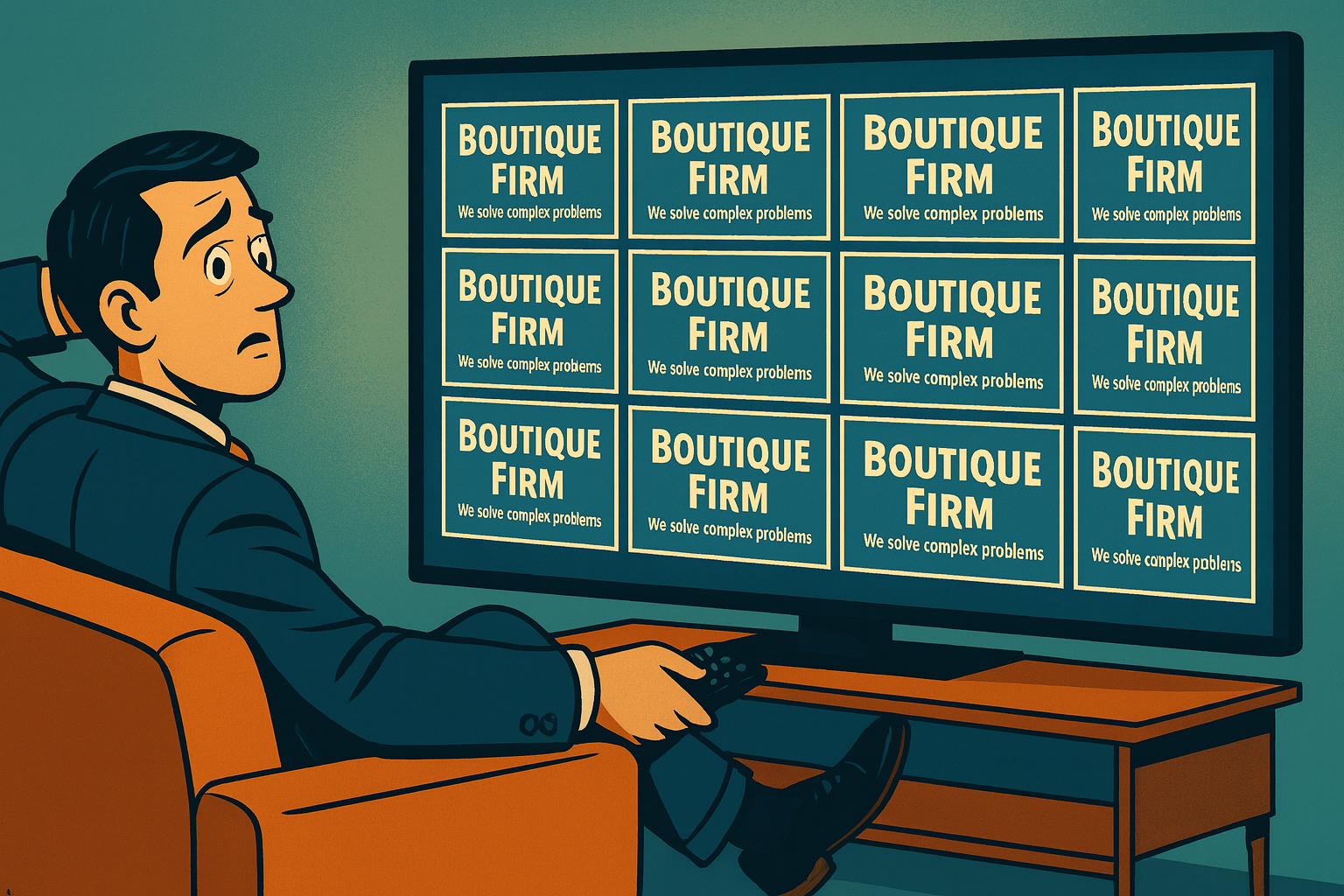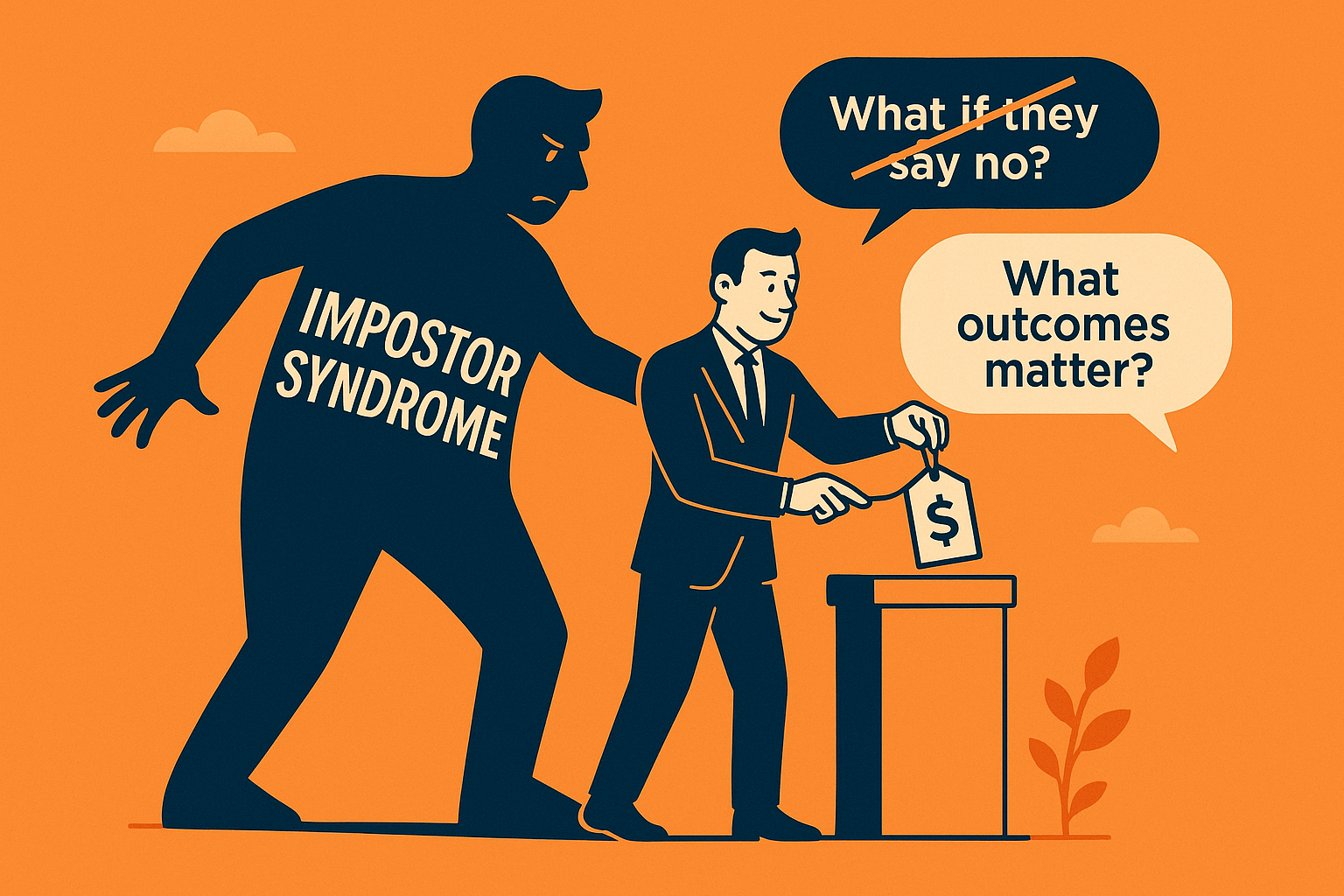Do you remember the last time you sat down to watch something on Netflix (or your other favorite streaming platform)? Do you remember the anxiety inducing scroll fest through all the mediocre content in an effort to find that diamond in the rough - that one show or movie that won't leave you disappointed with the time you wasted? The more content, these platforms host, the harder this choice becomes, even with the help of personalized curation and recommendation engines.
Now consider the scenario of having to choose a new consulting partner.
There are more than 1.3 million consulting firms in the U.S.
There are thousands of procurement firms
There are thousands of digital transformation firms
There are thousands of non-profit consulting firms
There are thousands of environmental consulting firms
There are thousands of pretty much any kind of firm you can think of.
Whether it's industry or capability specific, or both, competition is increasing. We have reached peak service commoditization.
Why the cost of getting it wrong exploded
Any time there is a major market shift, organizations need to adapt. That change is hard, and getting it wrong could mean the difference between exponential growth and fading into obscurity. This is nothing new, but the pace of change has accelerated dramatically in recent years. It's not just technological change. It's major societal changes, macroeconomic shifts, and everything in between, and all at once.
Every decision has an opportunity cost, and when things are changing this fast across so many factors all at once, that opportunity cost compounds. It's like opportunity cost on steroids. Moving slow is now expensive.
There is also an ever increasing number of choices for each buying decision. See "there over 1.3 million consulting firms in the United States" above. All these firms are attending more events, sending more emails, creating more content, running more ads, and making more phone calls. And many of them look and sound like all the rest. The noise to signal ratio has been ratched up to 100x.
Think about it - how many lead gen agencies have you received cold emails from recently? Or how many management consulting firms did you see at the last industry event you attended? More options means more second guessing - just like menu anxiety.
On top of all this, you now have significantly higher cost of capital. The cheap money is gone, and isn't coming back anytime soon. This means growth at all costs is gone too. In its place, we have an unrelenting ROI scrutiny. Every mistake is not only nominally more expensive, because capital costs will expose sloppy bets, it's potentially career ending, because CFOs are watching over investments more closely and taking over many decisions. This means that buyers are all looking out for themselves even more than they historically were.
And last, but definitely not least, is the specter of AI. Whether they are saying it openly or not, they are wondering whether the service you offer can be done better or faster by an LLM. Or, they are wondering whether you are simply prompting a model, and passing off the output as your own at the same high cost you always have. Deloitte just got caught doing this. By the way, I am really hoping you aren't doing that. For the love of the consulting profession, please don't do that. This proliferatio of GenAI is creating yet another reason for internal skepticism or external questioning as buying decisions are happening.
These are the four forces shaping the new risk equasion: pace of change, increased choice, increased cost of capital, and the specter of AI.
The New Risk Equation
The market didn’t just get noisier, it completely changed the risk equation: Risk = (Decision Time × Uncertainty × Cost Exposure) ÷ Learning Velocity. The four forces are pushing up the numerator (Time, Uncertainty, and Cost Exposure), while dragging down the denominator, Learning Velocity.
Let's explore these forces in a bit more detail:
1) Increased pace of change, means Decision Time and Uncertainty Increase
When tech, macro, and social shifts stack at once, every week you spend “deciding” is a week the landscape changes under your feet. Opportunity cost compounds, so Decision Time stretches, and with more moving parts, Uncertainty rises. The longer you wait, the less your assumptions hold. But the uncertainty that the rapid pace of change brings, makes it hard to move faster, contributing to analysis paralysis.
2) Increased choice, means Uncertainty and Decision Time Increase
An ever-growing menu of look-alike firms means more second-guessing and slower consensus. Signal is harder to isolate, so Uncertainty stays high. Buying committees, where everyone is looking out for themselves continue to deliberate, so Decision Time drifts. Buyers don't want more choice. They want more clarity. More choice actually multiplies paths to the wrong one. That's The Paradox of Choice
3) Increased cost of capital, means Cost Exposure increases and tolerance for lower Learning Velocity decreases
Cheap capital is gone. Every decision carries real cost exposure (actual cash spent, and the opportunity cost on that cash). So as interest rates go up, the cost exposure of every decision follows suit. With CFOs now scrutinizing ROI, simply learning from decisions isn't enough, because mistakes are interest-bearing, and the pressure to learn faster increases.
4) The specter of AI challenges assumptions about Learning Velocity and the Cost Exposure of certain types of activities
We consultants are hired for our thinking. More specifically, we are hired to use our thinking to bring clarity to our clients' decision making. That clarity is what increases Learning Velocity. Now buyers are internally asking: “Could a model + two sharp analysts do this faster?” If your approach can’t show where humans create the marginal value, the rate at which you are able to turn unknowns into knowns effectively falls. That means that any commodity task-oriented work priced like craft inflates Cost Exposure. Remember those 1.3 million consulting firms, and the service commoditization we are experiencing? Now we are back full circle.
So the net effect is higher Decision Time, Uncertainty, and Cost Exposure, and unless you position and design for it, lower Learning Velocity. That’s why the cost of getting it wrong isn’t a rounding error anymore.
What Buyers Are Really Trying to De-Risk
I've already written quite extensively about how buyers are really looking at risk, first from a personal risk perspective, and then from an organizational risk perspective. But there is another way we can parse the de-risking decision:
- Outcome risk:
- Personal: Will I get fired, if we don't get the desired business result?
- Organizational: Will we actually get the business result?
- Execution risk:
- Personal: Will my job become more difficult trying to help them navigate our internal constraints?
- Organizational: Can this team operate within our constraints (politics, data, messy ops)?
- Replacement risk:
- Personal: If this doesn't work out, how can I unwind and save face?
- Organizational: If it’s wrong, how fast can we unwind and pivot?
Remember, personal risk always trumps organizational risk when it comes to the buying decision, because we humans are selfish creatures. And this phenomenon only increases when the market is volatile the way it is right now. Nobody wants to be out hunting for a new job right now.
Your De-Risking Playbook
So what is a boutique firm to do in this environment? If you are a long-time reader, you probably already know where I am going with this - positioning is key. Not the veneer kind of positioning that's really just messaging wrapped in moniker of positioning. Real positioning where the firm actually takes a position (yep it's actually in the name), and does the hard work to actually own an idea in the minds of their ideal clients. But let's get a bit more specific, what should your firm do once you've made the positioning decision?
First, focus on speed-to-clarity. Think about how your intellectual property can help your ideal clients reframe a problem, think about it more clearly, and get to a decision faster. Going back to our risk equation - how can you increase their Learning Velocity?
Second, sell risk-reduction milestones. Stage gating shouldn't simply be an exercise in limiting the client's Cost Exposure. Think about your "proprietary proven process," do the phases tell your prospective client anything about how their Decision Making time will improve or their Uncertainty decrease? If not, you have your work cut out for you. Not only do you need to change the process language, you need to rework the actual delivery of the service to provide clear de-risking value at each stage.
Third, show real evidence of delivery success. Generic problem, solution, results case studies won't cut it. You need to show how your methodology has worked in the same or similar context as that of your ideal client - the same messy data, the same organizational misalignment, the same tech stack, etc. In addition to case studies, one of the best ways to show this, is to have your sales process act like a demo. Don't sell. Consult.
Fourth, paid discovery is your saving grace. Develop a diagnostic offering that allows you to decrease uncertainty about choosing you, and compress the decision making time. Something you can get done in 1 - 4 weeks is ideal, with a price tag that's small enough that your champion can put it on their corporate card without executive approval.
Fifth, be clear on leading indicators. Many consultants like to say that the outcome they are driving towards takes time. For some it's a cop-out, but for many its the truth. That doesn't change the fact that clients are risk averse, and will inevitably become anxious 30-days in if they don't see some indication of progress. For example, I openly tell my prospective clients that about a month in, their excitement will fade and they will become anxious. I also tell them that at that point, they should be looking for indicators of internal alignment (partners focused on the same ICP, teams using the same language, leadership excitement about the direction, etc.)
Sixth, and last but not least, give them a contractual way out. This might seem risky, but it actually shows confidence in your methodology. It also may allow you to charge more. There are many ways you can do this, but in an ideal world this is tied to the stage gating conversation we already had. Make this clear up front, to aleviate their personal risk fears.
Common Risk Traps
Many of these are pretty much the opposite of what I described above, but it's still worth emphasizing.
- Whole enchilata SOWs. Yes, it's exciting to sell that half-million dollar engagement, and it sure looks great in your pipeline report. But the likelihood of that thing getting approved is much lower than a stage gated proposal with clear de-risking milestones and a pre-determined exit path if things go south.
- Custom everything. It might seem that your client wants something tailor made for them because they believe their situation is unique. But in reality, what they really want is proof that what you will do has worked before, for someone like them. That means it most definitely shouldn't be custom.
- Underscoping discovery. The reason clients seem allergic to assessments and audits is because they have been bamboozled once too many times. They have been sold an audit that ended up just being a generic set of recommendations without any actionable prioritization, investment estimates, or ROI forecasts. But that doesn't mean you shouldn't pitch paid discovery. What you need to do is develop a paid diagnostic that earns its keep in 1 - 4 weeks.
- AI-washing. Yes, everyone is thinking and talking about AI right now. And whether they ask you openly or not, they are wondering whether you are using it, and if so how. You have two options. One - you tell them that you don't use it at all, and then make sure that you actually don't. Two - you tell them that you do use it, and explain exactly where human and machine intersect, and how the human is enabled and empowered to deliver and better result, faster.
Final Thought
In an environment where risk and volatility are ever increasing, the premium on providing clarity to improve decision velocity is at an all-time high. Position your firm in such a way where you can offer that clarity to a specific type of client for a specific set of decisions (read problems that need solutions).
If you want to see how risky your firm's positioning really is, take the Positioning Risk Assessment






